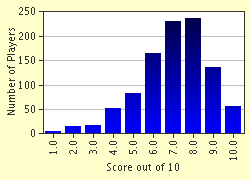Quiz Answer Key and Fun Facts
1. The origins of show-jumping lie in --.
2. In their first autumn, foals often _____ .
3. Horses roll for a variety of reasons. However, when a horse does this after he rolls, there is a chance he may have colic.
4. Other than dozing, there are ____ types of sleep.
5. Skewbald is _____ .
6. A horse's hearing is poor compared to that of humans.
7. A mare's pregnancy lasts ___ months.
8. If a horse repeatedly rests the same leg, it can mean that _____ .
9. What is roaring?
10. The origins of eventing lie in _____ .
Source: Author
Mongoose1
This quiz was reviewed by FunTrivia editor
crisw before going online.
Any errors found in FunTrivia content are routinely corrected through our feedback system.

